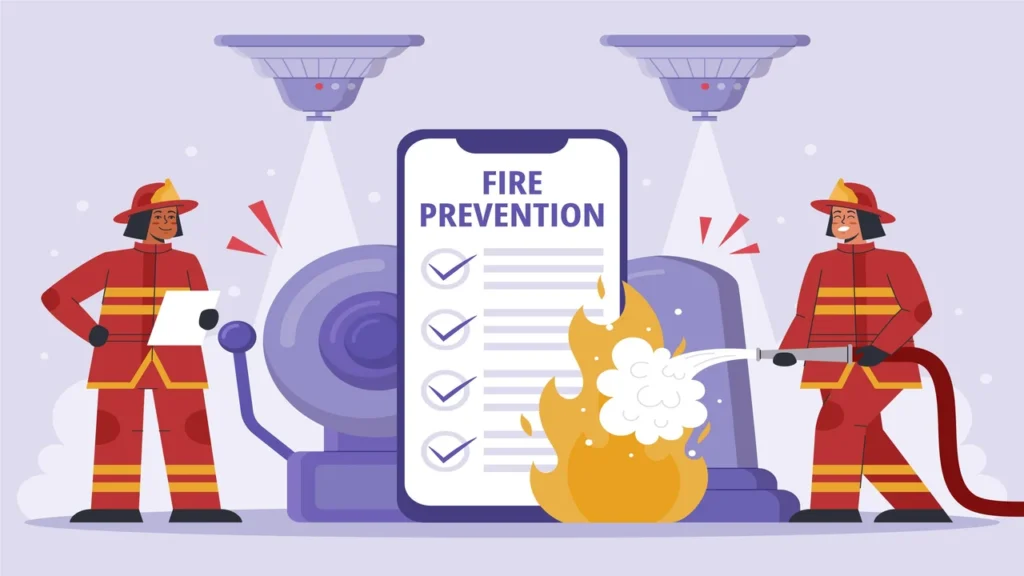A fire risk assessment is one of the most crucial steps you need to take when it comes to the safety of your property. Not only are you legally required to have a fire risk assessment conducted but it is your moral responsibility.
A fire risk assessment is conducted to detect points of vulnerability in a building’s structure as well as to eliminate fire risks. From faulty electrical systems to improper storage of hazardous or flammable material, fire risks can take many forms and a formal assessment is the best way to eliminate them.
Introduction to Fire Risk Assessment
Fire risk assessments are essential for keeping people safe and meeting regulations. They help find fire hazards, check potential fire risks, and put safety measures in place. These steps help protect lives and property.
What is a Fire Risk Assessment?
A fire risk assessment is a way of analyzing the blueprint and layout of a building and ensuring there are no chances of vulnerabilities to fire breaking out in the building, leading to injuries to the residents. A fire risk assessment also analyses the current safety measures installed in a building and tests them against modern regulations. A fire risk assessment is a small step in ensuring the safety of a building and the residents within.
Why is it Important?
Here’s why conducting a fire risk assessment is essential:
- Protect Lives: Fire Risk Assessments lower the chance of people getting hurt in the event of a fire. Using safety tools like alarms and extinguishers saves lives during emergencies.
- Prevent Property Damage: Fires can destroy homes and businesses, causing big losses. A fire risk assessment can help reduce that risk.
- Meet Legal Regulations: Following the Fire Safety Order 2005 avoids fines and other legal problems. Such attention to regulations also shows you are taking responsibility for safety.
If you’re looking to stay clear of legal troubles and keep your property safe, a fire risk assessment is definitely something you should consider.
Legal Responsibilities
There are always legal responsibilities that come with owning and/or renting out any properties. If you own a property, it is your legal responsibility to ensure the safety of the structure of the property and all residents living in the property as well.
Who is Responsible?
Under local laws, a “Responsible Person” must handle fire risk assessments. This could be:
- A business owner or employer
- A landlord or property manager
- Someone in charge of a building that isn’t a home
The Responsible Person must make sure safety measures are in place, and working and is also responsible for awareness of safety procedures.
Legal Obligations and Penalties
Not following fire safety rules can lead to:
- Large fines
- Legal charges
- Closing the building
Being compliant is both a legal and moral duty.
Steps for Conducting a Fire Risk Assessment
Here are some essential steps to conducting a fire risk assessment that you need to be aware of:
Step 1: Identify Fire Hazards
Finding fire hazards is the first step. It means looking closely at the building to see what might start a fire and what could keep it burning.
- Sources of Ignition
Look for things that could start a fire, like faulty electrical devices, open flames, or hot surfaces. For example, worn-out wires or overloaded sockets are common risks.
- Combustible Materials
Check for things that could fuel a fire, like paper, fabric, or flammable liquids. Pay extra attention to storage areas where these materials might pile up.
Step 2: Identify People at Risk
Think about who might be in danger during a fire. Consider how many people are in the building, how mobile they are, and if they know the layout well.
- Employees, Visitors, and Vulnerable Groups
Special care is needed for people who might struggle in a fire, like kids, the elderly, or those with disabilities. These at-risk groups will need extra help to stay safe.
Step 3: Evaluate, Remove, or Reduce Risks
Look at the risks you found and take steps to lower or remove them. Focus on the most serious risks first.
Safety Measures to Implement
- Add fire alarms and extinguishers.
- Keep escape routes clear.
- Check electrical systems regularly.
- Use fire-safe storage for flammable items.
Make sure staff know how to use fire safety tools and follow evacuation plans.
Step 4: Record Findings and Prepare a Plan
Write down what you found and make a fire safety plan. A plan will show that you are serious about safety and regulations as a whole.
- Emergency Plans and Training
Teach everyone what to do in a fire and hold regular drills. Practice helps people stay calm and act quickly in real emergencies. Keep training updated so everyone knows the latest safety steps.
Step 5: Review and Update Regularly
There are no specific regulations regarding how often the assessments should be reviewed except that they should be done “regularly”. Here’s how often we recommend you review them:
When to Review
- If there is reason to believe the assessment is invalid (due to a recent fire).
- Significant changes to the building’s structure (renovations or additions).
- Once a year (recommended, even if there are no big changes).
Also, review the plan if fire safety laws change to make sure you’re still compliant.
Fire Safety Precautions
Read below to ensure that you are taking all the necessary precautions when it comes to protecting from risks related to fire:
- Fire Detection and Warning Systems
Fire alarms are key to keeping people safe. They detect smoke or heat and warn everyone quickly. Test the alarms periodically and choose alarms that fit the requirements.
- Emergency Lighting and Exit Routes
Make sure escape routes are easy to see and use. Emergency lights help when power goes out during a fire. Signs showing exits and meeting points should be clear and visible, even in smoke or darkness.
- Fire Extinguishers and Signage
Have the right fire extinguishers for the types of fires that could happen. For example, electrical fires need different extinguishers than grease fires. Put up clear signs to show where the extinguishers are and how to use them.
Additional Considerations
Here are some more things you should be keeping in mind if you own a property and want to keep it safe from fire-related accidents.
- Managing Dangerous Substances
Handle flammable and hazardous items carefully. Store, label, and dispose of them properly to reduce risks. Do make sure that you follow safety rules as well as the best practices for handling such items.
- Heritage and Complex Buildings
Old or unusual buildings need extra care during fire risk assessments. Their unique features, like narrow stairs or hidden rooms, may need special safety proceedings to protect the people and the building itself.
Common Questions About Fire Risk Assessments
These are some questions that everybody has regarding fire risk assessments:
- Can I Do It Myself?
We do not recommend this practice as it’s better to hire a pro, whether it’s a big or complex building or even a small apartment. DIY assessments can be risky, as there is a chance you might miss something, leading to gaps in safety.
- Do I Need a Competent Person?
A trained expert can spot hidden risks and suggest proper fixes. They ensure the assessment is thorough and meets regulations.
- What Happens During an Inspection?
Fire risk assessment inspectors look for:
- Fire hazards
- Risks to people
- Gaps in safety measures
The inspector might also test alarms, check fire exits, and review your safety plan to make sure everything works as it should.
Action Plan Template
If you are conducting a fire risk assessment or having one conducted, be sure to follow this template:
Checklist for Responsible Persons
- Find fire hazards.
- Check safety tools.
- Train everyone on fire safety.
- Update the safety plan regularly.
Example Plan for Identifying and Addressing Risks
- Spot fire risks, like faulty plugs.
- Move flammable items away from heat sources.
- Add more smoke alarms where needed.
- Train staff on how to leave the building safely.
A clear plan makes it easier to fix problems and stay safe.
Fire Risk Assessment Services
Fire risk assessment is something you can’t choose to ignore. Therefore, if you are looking for to get this hurdle over with, you’ve come to the right place.
Why Choose Professional Assistance?
Choose professional assistance for the betterment of your property as our experts bring a wealth of knowledge and experience to the job. They’re fast and make sure your building falls under regulations. This is especially helpful for tricky or high-risk situations.
Our Expertise
We have years of experience in fire safety. Our team knows how to handle unique challenges, like creating complex safety plans or working with historic buildings. And we are sure to customize our services according to what you require.
FAQs and Resources
If you have any more questions regarding anything, you may refer to the guides and tools we’ve linked below or you may contact us for questions regarding our services.
Helpful Links to Official Guidelines and Tools
Check trusted resources like government websites for tips and tools, such as the Health & Safety Executive (HSE). The guides you find here can help you stay safe and meet all regulations.
Contact Information for Support
Need help? Contact us immediately. Whether you have questions or need a full assessment, we’re here to help.





